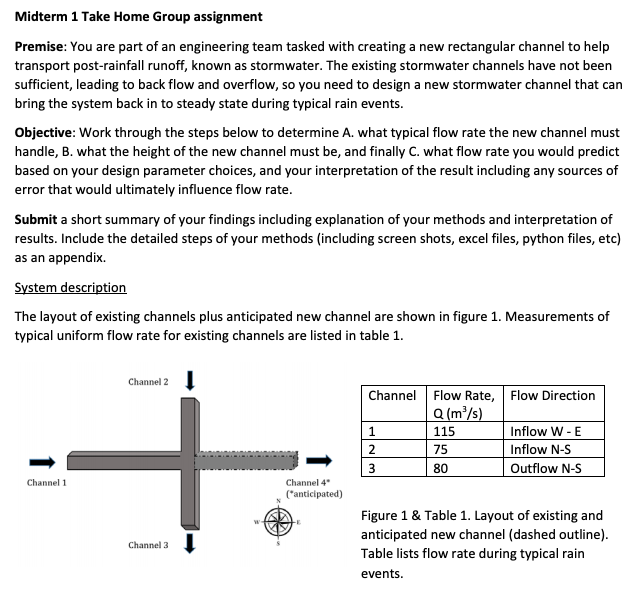
Midterm 1 Take Home Group assignment Premise: You are part of an engineering team tasked with creating a new rectangular channel to help transport post-rainfall runoff, known as stormwater. The existing stormwater channels have not been sufficient, leading to back flow and overflow, so you need to design a new stormwater channel that can bring the system back in to steady state during typical rain events Objective: Work through the steps below to determine A. what typical flow rate the new channel must handle, B. what the height of the new channel must be, and finally C. what flow rate you would predict based on your design parameter choices, and your interpretation of the result including any sources of error that would ultimately influence flow rate Submit a short summary of your findings including explanation of your methods and interpretation of results. Include the detailed steps of your methods (including screen shots, excel files, python files, eto) as an appendix. The layout of existing channels plus anticipated new channel are shown in figure 1. Measurements of typical uniform flow rate for existing channels are listed in table 1 Channel 2 ChannelFlow Rate, Flow Direction Q (m/s 115 75 80 Inflow W-E Inflow N-S Outflow N-S Channel 1 Channel 4* Figure 1 & Table 1. Layout of existing and anticipated new channel (dashed outline) Table lists flow rate during typical rain events Channel 3 Midterm 1 Take Home Group assignment Premise: You are part of an engineering team tasked with creating a new rectangular channel to help transport post-rainfall runoff, known as stormwater. The existing stormwater channels have not been sufficient, leading to back flow and overflow, so you need to design a new stormwater channel that can bring the system back in to steady state during typical rain events Objective: Work through the steps below to determine A. what typical flow rate the new channel must handle, B. what the height of the new channel must be, and finally C. what flow rate you would predict based on your design parameter choices, and your interpretation of the result including any sources of error that would ultimately influence flow rate Submit a short summary of your findings including explanation of your methods and interpretation of results. Include the detailed steps of your methods (including screen shots, excel files, python files, eto) as an appendix. The layout of existing channels plus anticipated new channel are shown in figure 1. Measurements of typical uniform flow rate for existing channels are listed in table 1 Channel 2 ChannelFlow Rate, Flow Direction Q (m/s 115 75 80 Inflow W-E Inflow N-S Outflow N-S Channel 1 Channel 4* Figure 1 & Table 1. Layout of existing and anticipated new channel (dashed outline) Table lists flow rate during typical rain events Channel 3







